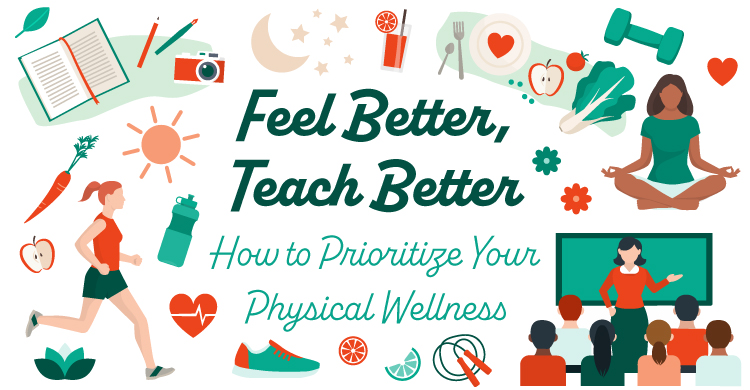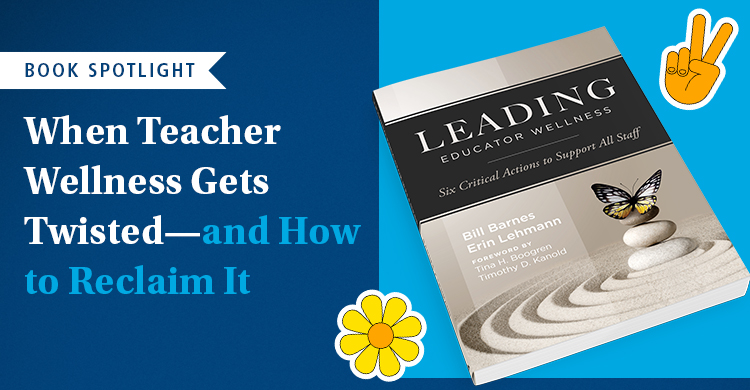The demands of being an educator can often feel overwhelming, with long hours, constant multitasking, and the emotional weight of supporting students. This constant pressure doesn’t just affect our mental health but also takes a direct toll on our physical well-being. Skipping meals, not drinking enough water, sacrificing sleep, and neglecting exercise can become the norm in an effort to keep up with daily responsibilities of teacher life. Over time, these habits can lead to teacher burnout, leaving us drained and unable to bring our best selves to the classroom. You may be asking yourself: Where, as an educator, can I possibly find time to prioritize my physical wellness?
“Our goal as educators is to make a difference in the lives of our students—both academically and social-emotionally. We cannot do that if we aren’t taking care of ourselves.” — Tina H. Boogren
Simplicity is the secret to better physical wellness
Prioritizing your physical wellness may, at first, feel like a juggling act. With the pressures of lesson planning, grading, and managing classroom dynamics, it can seem overwhelming to add another item to your to-do list. However, the key to success is keeping it simple and focusing on small, manageable steps. You don’t need to overhaul your entire routine overnight. Start with small changes that are easy to implement. Once you start to slowly implement small changes, you’ll notice how they all work together. It’s important to remember that the aspects of physical wellness are interconnected, like the pieces of a puzzle—each one supporting the other to create a healthier, more balanced you.
“…Educator wellness is not a singular event. It is a process of self-reflecting routines for a lifetime of continuous growth and improvement—every day, every month, every season, every school year.”
— Educator Wellness: A Guide for Sustaining Physical, Mental, Emotional, and Social Well-Being
These small steps matter more than you might think. Over time, they can lead to significant improvements in your energy levels, mood, and overall productivity.
5 wellness priorities to gradually adopt for better health
1. Mindful Eating: Fueling your body for success
Mindful eating is more than just choosing healthy foods; it’s about truly tuning into how your body responds to what you’re eating and how it fuels you throughout the day. By being mindful, you can avoid the typical sugar crashes or energy slumps that come from reaching for processed, quick fixes. Instead of reaching for processed foods, aim for simple, fresh ingredients. Shop the outer aisles of the grocery store and prepare meals at home, using leftovers for school lunches to support your overall wellness.
For educators, having balanced meals and snacks can keep your energy steady and reduce feelings of burnout. Simple adjustments, like opting for wholesome foods over processed snacks, can greatly improve your stamina, helping you manage long school days and stay present in the classroom.
2. Hydration: The power of water
Staying hydrated does more than just boost energy—it also enhances focus and improves your mood, which is essential for getting through long teaching days. Proper hydration helps maintain cognitive function, keeping your mind sharp and your concentration steady. When you’re well-hydrated, you’re better equipped to handle the mental and emotional demands of the classroom, stay patient with students, and avoid the sluggishness that often comes from dehydration.
3. Movement: Finding time to stay active
Finding time to move during busy teaching days may seem challenging, but even small moments of physical activity can make a big difference. Simple actions like stretching in between classes, taking short walks, or standing while grading papers can be enough to break up long periods of sitting.
Movement is crucial for relieving stress and boosting mental clarity, helping you feel more focused and energized throughout the day. Think about your current movement habits: When do you move, how often, and what kind of movement are you incorporating? Create a movement playlist with upbeat music or set reminders to get up and move throughout the day. Reducing sitting time is just as important as a workout. Start small, and make movement a natural part of your routine—any movement is better than none!
— 180 Days of Self-Care for Busy Educators
4. Sleep: The unsung hero of wellness
Sleep routines play a crucial role in our overall wellness. If we don’t get enough rest, our bodies often crave caffeine and sugar, leading to a blood sugar roller coaster that leaves us wired, tired, and burnt out by the end of the day. A solid night of sleep not only replenishes energy but also improves our food choices the next day. Research shows that sleep-deprived people tend to reach for high-calorie foods. Consider whether you’re well-rested and ready to take on the day, or if you’re feeling sluggish and drained. What changes could help you wake up feeling more energized? Tracking your sleep habits can help you identify patterns and make adjustments that support better wellness choices.
5. Rest: Learning to pause
When was the last time you gave yourself a few minutes to rest? While sleep is essential for recovery, rest is about creating intentional moments of calm throughout your day. A quick break, a walk outside, or even five minutes of deep breathing can reduce stress and give you a much-needed energy boost.
Rest doesn’t require a nap or retreat—it’s about finding small ways to reset. Even brief moments of rest can prevent burnout, increase creativity, and make you more productive, helping you return to your tasks feeling refreshed and ready to go.
Teacher wellness is the foundation for a positive classroom culture and long-term teacher retention. How often do we stop to think about how food, water, movement, sleep, and rest are connected? Prioritizing all five areas and recognizing their synergy helps you bring your best self to the classroom. Small, intentional choices enhance your health and student connections, ensuring that when you feel better, you teach better.
About the educator
Tina H. Boogren, PhD, is a fierce advocate for educators, particularly for their well-being. She is the author of numerous best-selling books centered around her passion areas of quality instruction, coaching, mentoring, and wellness. Dr. Boogren will be a leading expert at Solution Tree’s upcoming workshop, Cultivating Educator Wellness for Elevated Student Achievement and Teacher Retention, October 3–4, in Centennial, Colorado.







